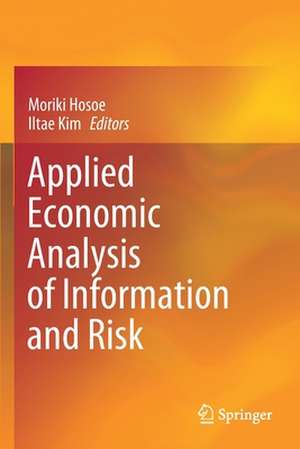Applied Economic Analysis of Information and Risk
Editat de Moriki Hosoe, Iltae Kimen Limba Engleză Paperback – 26 mar 2021
The book consists of two parts. In Part I, several aspects of applied economics are investigated, including public policy, labor economics, and political economics, from the standpoint of the economics of (asymmetric) information. First, several basic frameworks of the incentive mechanism with regard to transaction-specific investment are assessed, then various tools for market design and organization design are explored.
In Part II, mathematical measures of risk and risk aversion are examined in more detail, and readers are introduced to stochastic selection rules governing choice behavior under uncertainty. Several types of change in the random variable for the cumulative distribution function (CDF) and probability distribution function (PDF) are discussed. In closing, the part investigates the comparative static results of these changes in CDF or PDF on the general decision model, incorporating uncertain situations in applied economics.
| Toate formatele și edițiile | Preț | Express |
|---|---|---|
| Paperback (1) | 722.75 lei 6-8 săpt. | |
| Springer Nature Singapore – 26 mar 2021 | 722.75 lei 6-8 săpt. | |
| Hardback (1) | 728.74 lei 6-8 săpt. | |
| Springer Nature Singapore – 26 mar 2020 | 728.74 lei 6-8 săpt. |
Preț: 722.75 lei
Preț vechi: 881.40 lei
-18% Nou
Puncte Express: 1084
Preț estimativ în valută:
138.29€ • 144.78$ • 114.43£
138.29€ • 144.78$ • 114.43£
Carte tipărită la comandă
Livrare economică 05-19 aprilie
Preluare comenzi: 021 569.72.76
Specificații
ISBN-13: 9789811533020
ISBN-10: 9811533024
Ilustrații: VIII, 202 p. 80 illus.
Dimensiuni: 155 x 235 mm
Greutate: 0.3 kg
Ediția:1st ed. 2020
Editura: Springer Nature Singapore
Colecția Springer
Locul publicării:Singapore, Singapore
ISBN-10: 9811533024
Ilustrații: VIII, 202 p. 80 illus.
Dimensiuni: 155 x 235 mm
Greutate: 0.3 kg
Ediția:1st ed. 2020
Editura: Springer Nature Singapore
Colecția Springer
Locul publicării:Singapore, Singapore
Cuprins
Introduction: Applied Economics of Information and Risk.- An Incentive Mechanism with regard to Transaction-Specific Investment, and Information.- Bidding Mechanism of Monitoring and Collusion.- Effectiveness of Mandatory Disclosure for Consumer Policy.- Asymmetric Information, Ex-ante Regulation, and Ex-post Regulation.- Effort Observability and Wage and Promotion in an Internal Labor Market.- Comparative Analysis of Politician-Bureaucratic Governance Structure.- Risk and Risk Aversion.- The Subclasses of First-degree Stochastic Dominance (FSD) Shift and Their Comparative Static Analysis with Financial Market.- The Subclasses of Rothschild and Stiglitz (R-S) Increases in Risk and their Comparative Static Analysis and Insurance Market.- Some Relationships among FSD shifts and R-S increases in Risk with Labor Behavior.- Natural Desaster, Civil liability, and Safety Investment.- Environmental Risk and Extended liability.
Notă biografică
Moriki Hosoe, Emeritus Professor, Kyushu University
Iltae Kim, Professor, Chonnan National University
Textul de pe ultima copertă
This book examines interesting new topics in applied economics from the perspectives of the economics of information and risk, two fields of economics that address the consequences of asymmetric information, environmental risk and uncertainty for the nature and efficiency of interactions between individuals and organizations. In the economics of information, the essential task is to examine the condition of asymmetric information under which the information gap is exploited. For the economics of risk, it is important to investigate types of behavior including risk aversion, risk sharing, and risk prevention, and to reexamine the classical expected utility approach and the relationships among several types of the changes in risk. Few books have ever analyzed topics in applied economics with regard to information and risk. This book provides a comprehensive collection of applied analyses, while also revisiting certain basic concepts in the economics of information and risk.
The book consists of two parts. In Part I, several aspects of applied economics are investigated, including public policy, labor economics, and political economics, from the standpoint of the economics of (asymmetric) information. First, several basic frameworks of the incentive mechanism with regard to transaction-specific investment are assessed, then various tools for market design and organization design are explored.
In Part II, mathematical measures of risk and risk aversion are examined in more detail, and readers are introduced to stochastic selection rules governing choice behavior under uncertainty. Several types of change in the random variable for the cumulative distribution function (CDF) and probability distribution function (PDF) are discussed. In closing, the part investigates the comparative static results of these changes in CDF or PDF on the general decision model, incorporating uncertain situations in applied economics.
The book consists of two parts. In Part I, several aspects of applied economics are investigated, including public policy, labor economics, and political economics, from the standpoint of the economics of (asymmetric) information. First, several basic frameworks of the incentive mechanism with regard to transaction-specific investment are assessed, then various tools for market design and organization design are explored.
In Part II, mathematical measures of risk and risk aversion are examined in more detail, and readers are introduced to stochastic selection rules governing choice behavior under uncertainty. Several types of change in the random variable for the cumulative distribution function (CDF) and probability distribution function (PDF) are discussed. In closing, the part investigates the comparative static results of these changes in CDF or PDF on the general decision model, incorporating uncertain situations in applied economics.
Caracteristici
Analyzes current issues in applied economics from the perspectives of the economics of information and risk Investigates regulation policy, consumer policy, and political procedure with regard to asymmetric information Focuses on fundamental risk analysis concepts for applied analysis in the financial market, labor market, and environment
